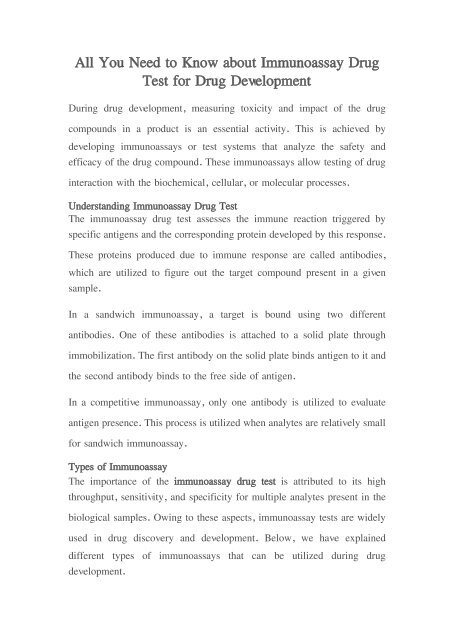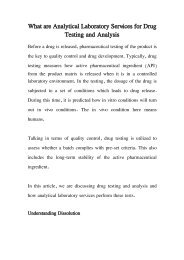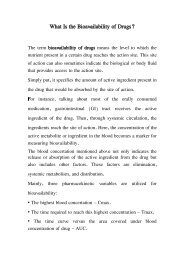All You Need to Know about Immunoassay Drug Test for Drug Development
During drug development, measuring toxicity and impact of the drug compounds in a product is an essential activity. This is achieved by developing immunoassays or test systems that analyze the safety and efficacy of the drug compound.
During drug development, measuring toxicity and impact of the drug compounds in a product is an essential activity. This is achieved by developing immunoassays or test systems that analyze the safety and efficacy of the drug compound.
- No tags were found...
Create successful ePaper yourself
Turn your PDF publications into a flip-book with our unique Google optimized e-Paper software.
<strong>All</strong> <strong>You</strong> <strong>Need</strong> <strong>to</strong> <strong>Know</strong> <strong>about</strong> <strong>Immunoassay</strong> <strong>Drug</strong><br />
<strong>Test</strong> <strong>for</strong> <strong>Drug</strong> <strong>Development</strong><br />
During drug development, measuring <strong>to</strong>xicity and impact of the drug<br />
compounds in a product is an essential activity. This is achieved by<br />
developing immunoassays or test systems that analyze the safety and<br />
efficacy of the drug compound. These immunoassays allow testing of drug<br />
interaction with the biochemical, cellular, or molecular processes.<br />
Understanding <strong>Immunoassay</strong> <strong>Drug</strong> <strong>Test</strong><br />
The immunoassay drug test assesses the immune reaction triggered by<br />
specific antigens and the corresponding protein developed by this response.<br />
These proteins produced due <strong>to</strong> immune response are called antibodies,<br />
which are utilized <strong>to</strong> figure out the target compound present in a given<br />
sample.<br />
In a sandwich immunoassay, a target is bound using two different<br />
antibodies. One of these antibodies is attached <strong>to</strong> a solid plate through<br />
immobilization. The first antibody on the solid plate binds antigen <strong>to</strong> it and<br />
the second antibody binds <strong>to</strong> the free side of antigen.<br />
In a competitive immunoassay, only one antibody is utilized <strong>to</strong> evaluate<br />
antigen presence. This process is utilized when analytes are relatively small<br />
<strong>for</strong> sandwich immunoassay.<br />
Types of <strong>Immunoassay</strong><br />
The importance of the immunoassay drug test is attributed <strong>to</strong> its high<br />
throughput, sensitivity, and specificity <strong>for</strong> multiple analytes present in the<br />
biological samples. Owing <strong>to</strong> these aspects, immunoassay tests are widely<br />
used in drug discovery and development. Below, we have explained<br />
different types of immunoassays that can be utilized during drug<br />
development.
Radioimmunoassay<br />
In radioimmunoassay, the antigen related <strong>to</strong> the drug development is<br />
attached with a radioiso<strong>to</strong>pe and bound <strong>to</strong> the complementary antibody.<br />
After achieving this, the sample antigen is added <strong>to</strong> replace the radioactive<br />
antigen. Once the process is completed, the unbound antigens are washed<br />
away and radioactivity is calculated. The sample’s radioactivity is<br />
inversely proportional <strong>to</strong> the target antigen.<br />
Enzyme-Linked Immunosorbent Assay<br />
In the ELISA immunoassay, an enzyme is connected <strong>to</strong> the antibody,<br />
which goes through incubation. After incubation is completed, the<br />
unbound antigens are removed or washed so that antibody-enzyme can be<br />
measured. This is achieved by the addition of a substrate <strong>to</strong> the final<br />
solution. A chemical reaction relevant <strong>to</strong> the substrate caused by the<br />
enzyme leads <strong>to</strong> change, which is then used <strong>to</strong> analyze the target antigen.<br />
Counting <strong>Immunoassay</strong><br />
The counting immunoassay process is carried out by coating multiple<br />
antibodies <strong>to</strong> the polystyrene beads. These antibodies and the target antigen<br />
are complementary <strong>to</strong> each other. When the polystyrene beads are exposed<br />
<strong>to</strong> incubation, antigens and beads bind <strong>to</strong>gether <strong>to</strong> <strong>for</strong>m a large mass. The<br />
unbounded beads are calculated through a cell counter. These calculated<br />
unbounded beads are inversely proportional <strong>to</strong> the antigen.<br />
Chemiluminescence <strong>Immunoassay</strong><br />
The chemiluminescence immunoassay is similar <strong>to</strong> the ELISA<br />
immunoassay. The antibody or antigen is coated over solid particles. After<br />
incubation of these particles, the substrate is added <strong>to</strong> the solution which
generates light. This intensity of the light is measured as it is directly<br />
proportional <strong>to</strong> the target antigen.<br />
Fluro <strong>Immunoassay</strong><br />
The fluorescent probes are utilized <strong>to</strong> label the antibodies, which are then<br />
exposed <strong>to</strong> antigen incubation. After completion of the incubation process,<br />
the intensity of the fluorescent is measured.<br />
<strong>Immunoassay</strong> tests in <strong>Drug</strong> <strong>Development</strong><br />
<strong>Immunoassay</strong> tests are widely utilized <strong>for</strong> drug moni<strong>to</strong>ring,<br />
pharmacokinetic, <strong>to</strong>xicokinetic, and bioequivalence analysis of drug<br />
development. The type of immunoassay <strong>for</strong> a particular drug discovery<br />
experiment is decided, based upon various goals of the study. Selecting the<br />
right method is imperative <strong>for</strong> successful completion of different drug<br />
development phases. Hence, it is very important <strong>to</strong> assess the requirements<br />
of the experiment be<strong>for</strong>e proceeding with any of the above immunoassay<br />
tests.





